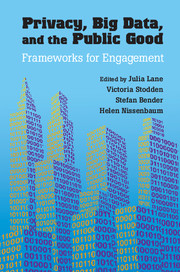Book contents
- Frontmatter
- Dedication
- Contents
- Contributors
- Editors’ Introduction
- Part I Conceptual Framework
- Part II Practical Framework
- 6 The Value of Big Data for Urban Science
- 7 Data for the Public Good: Challenges and Barriers in the Context of Cities
- 8 A European Perspective on Research and Big Data Analysis
- 9 The New Deal on Data: A Framework for Institutional Controls
- 10 Engineered Controls for Dealing with Big Data
- 11 Portable Approaches to Informed Consent and Open Data
- Part III Statistical Framework
- References
6 - The Value of Big Data for Urban Science
Published online by Cambridge University Press: 05 July 2014
- Frontmatter
- Dedication
- Contents
- Contributors
- Editors’ Introduction
- Part I Conceptual Framework
- Part II Practical Framework
- 6 The Value of Big Data for Urban Science
- 7 Data for the Public Good: Challenges and Barriers in the Context of Cities
- 8 A European Perspective on Research and Big Data Analysis
- 9 The New Deal on Data: A Framework for Institutional Controls
- 10 Engineered Controls for Dealing with Big Data
- 11 Portable Approaches to Informed Consent and Open Data
- Part III Statistical Framework
- References
Summary
Introduction
The past two decades have seen rapid advances in sensors, database technologies, search engines, data mining, machine learning, statistics, distributed computing, visualization, and modeling and simulation. These technologies, which collectively underpin ‘big data’, are allowing organizations to acquire, transmit, store, and analyze all manner of data in greater volume, with greater velocity, and of greater variety. Cisco, the multinational manufacturer of networking equipment, estimates that by 2017 there will be three networked devices for every person on the globe. The ‘instrumenting of society’ that is taking place as these technologies are widely deployed is producing data streams of unprecedented granularity, coverage, and timeliness.
The tsunami of data is increasingly impacting the commercial and academic spheres. A decade ago, it was news that Walmart was using predictive analytics to anticipate inventory needs in the face of upcoming severe weather events. Today, retail (inventory management), advertising (online recommendation engines), insurance (improved stratification of risk), finance (investment strategy, fraud detection), real estate, entertainment, and political campaigns routinely acquire, integrate, and analyze large amounts of societal data to improve their performance. Scientific research is also seeing the rise of big data technologies. Large federated databases are now an important asset in physics, astronomy, the earth sciences, and biology. The social sciences are beginning to grapple with the implications of this transformation. The traditional data paradigm of social science relies upon surveys and experiments, both qualitative and quantitative, as well as exploitation of administrative records created for non-research purposes. Well-designed surveys generate representative data from comparatively small samples, and the best administrative datasets provide high-quality data covering a total population of interest. The opportunity now presents to understand how these traditional tools can be complemented by large volumes of ‘organic’ data that are being generated as a natural part of a modern, technologically advanced society. Depending upon how sampling errors, coverage errors, and biases are accounted for, we believe the combination can yield new insights into human behavior and social norms.
- Type
- Chapter
- Information
- Privacy, Big Data, and the Public GoodFrameworks for Engagement, pp. 137 - 152Publisher: Cambridge University PressPrint publication year: 2014
References
- 3
- Cited by



